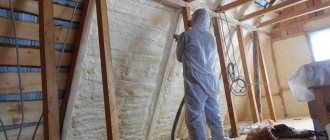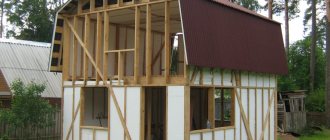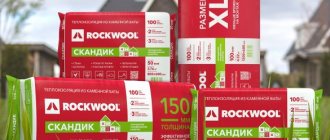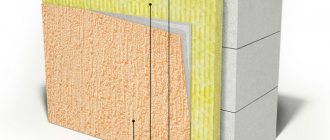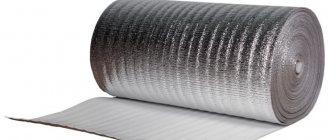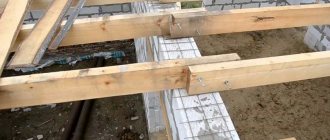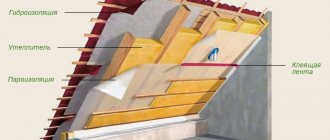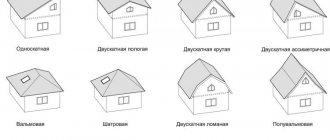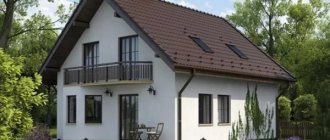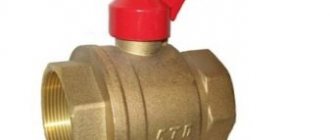Internal insulation of the attic has an undeniable advantage - the ability to carry out thermal insulation work regardless of the season. However, this approach has several important nuances, ignoring which can negate all efforts and financial investments. It’s easier to prevent unwanted consequences than to eliminate them, don’t you agree?
We will tell you how to act correctly to avoid mistakes. In the article, we described the features of using different thermal insulation materials, gave tips on choosing the best insulation, and also told how to avoid the appearance of condensation in the roofing pie.
The detailed technology for insulating an attic roof will help you do all the work yourself, without the help of specialists.
Useful information and video on how to insulate an attic for winter living
A lot depends on the quality insulation of the attic roof. If you plan to use this space during the winter, you need to think carefully about what materials to use for insulation. Another important aspect is the roof design.
If the roof geometry is very complex, you may have to sacrifice some area to retain heat
The peculiarity of the under-roof space is not only in geometry; in winter it is colder here than in other rooms, and in summer it is hotter. To maintain optimal temperature, roofers recommend forming a multi-layer “pie” of waterproofing, vapor barrier and insulation under the roofing.
Important point! When there is a large heat loss through the roof in winter, the snow on it begins to melt and forms an ice crust. And water, as you know, looks for any, even the most minimal, loophole. So an icy roof is bad, there is a high chance that you will get a leak.
High-quality thermal insulation will prevent heating of the roofing material and the formation of ice
And now a short video to get a general idea of attic insulation:
Roofing pie device
The attic roof has several functional layers. The types of roofs with their structures vary in degree of complexity.
Collectively, the layers of the attic roof are called a roofing pie (another way to insulate an attic roof).
There are 2 types of attic: used and cold. The roof structure is selected taking into account the choice of attic structure.
In the case of a cold attic layout, only the ceiling is insulated.
If you plan to have an attic, you will need to insulate the roof.
It is in this case that a roofing pie is created.
The pie consists of:
- interior decoration,
- lathing,
- vapor barrier layer,
- counter battens,
- insulation,
- waterproofing,
- ventilation gap,
- roofing material.
Carefully! It is very important to maintain the correct chain of layers, since each of the elements performs its own specific function. If the order of layers is incorrect, the thermal insulation characteristics of the roof will be impaired, which will lead to damage to the building material. We recommend that you familiarize yourself with the detailed diagram of roof insulation with your own hands.
Preparing the under-roof space for insulation
You should know that, according to GOST standards, the height of ceilings in the attic cannot be less than 2.5 meters. But this does not apply to the entire area of the attic, but only to half of it, that is, in the remaining 50 percent, the height of the room may be slightly less.
What factors influence heat loss in the attic floor:
- type of main building material of the house;
- the presence of common communications with other rooms of the house;
- features of roof geometry, number and shape of slopes;
- type of load-bearing roof materials;
- placement of the attic relative to the main building (with access beyond its boundaries or not).
All these factors must be taken into account before you begin to insulate the roof from the inside with your own hands. Building regulations dictate that insulation of a house must be carried out from the outside so that the freezing point moves to its outer part. But this rule does not apply to attic floors. Here, the specifics of construction require internal insulation, since roofing material must be placed outside.
The only surface that can be insulated from the outside is the roof gable
In terms of preparation for insulation work, you need to carefully study the options for thermal insulation coating and select a high-quality waterproofing film.
A little about choosing tools
If you ask an experienced roofer what tools are needed to insulate the attic roof of a private house, he will shrug his shoulders and say: a hammer, a knife, a head and hands. For the most part, this is true, but there are trade secrets that not everyone wants to share.
The most important trick is in choosing a knife. If you take a simple construction and installation knife, you will suffer throughout the entire process, unevenly cutting the insulation. The blade of such a tool is too short; it does not cut through the thick layer of insulating material. In addition, the mounting knife will quickly become dull on mineral wool or foam plastic.
You can get by with a handy cutting tool (a hacksaw) or use a wide kitchen knife for cutting bread with serrated sharpening.
Professional cutting tool – a wide, long knife made of carbon steel. The blade length is 35 centimeters, the handle is made of durable plastic and is very comfortable to use.
In addition to a good knife, you really need a hammer, as well as self-tapping screws and a screwdriver, a strong cord, protective clothing, a respirator and goggles.
Tips for cutting insulation:
- the room in which you will cut mineral wool should be well ventilated;
- hands, head and, especially, eyes and respiratory tract must be protected from penetration of flying fibers;
- after working with insulation, you need to take a shower, wash your hands and face thoroughly;
- the material needs to be cut across the fiber - this will reduce flying debris;
- In order not to be mistaken in the size of the pieces, you should carefully measure their locations.
It is better not to unwind roll insulation, but to cut it directly into the roll
What is polyurethane foam
Polyurethane foam (abbreviated as PPU) was created in Germany in the late thirties of the last century for the needs of the aviation and military industries. Later it began to be used for thermal insulation of freezers and refrigerators, and by the seventies of the twentieth century it began to be used for insulation of residential buildings.
Polyurethane foam is a plastic permeated with millions of tiny air bubbles. The insulation consists of two components, which are mixed directly at the insulation site in a special apparatus.
The components are supplied in separate containers attached to a special spraying apparatus. When the mixture is sprayed and interacts with carbon dioxide contained in the air, a light foam is formed that adheres well to any surface. After some time, the foam hardens, and the insulated surface is covered with a continuous layer of durable material - polyurethane foam.
In this way, an insulating layer is created that protects the premises from energy loss.
Polyurethane foam layer
Choosing insulation for an attic roof
Don’t rush to buy the first insulation you come across that you like because it looks thick or has bright packaging. A suitable material must meet strict requirements, let's look at them in more detail:
| Requirement | Explanations |
| Low thermal conductivity | This is the most understandable condition. The insulation should retain heat as much as possible, at the same time keep its shape well and withstand high temperatures. |
| Noise insulation | Can you imagine how difficult it will be for you to fall asleep if the rain begins to drum on the metal slopes, and the roof insulation does not absorb this noise? If the roof is iron, you cannot do without sound insulation. |
| Moisture resistance | The insulation should not absorb moisture. We are talking not only about possible leaks, but also about atmospheric moisture. If the thermal insulation layer absorbs water like a sponge, it will soon become deformed and lose its properties. |
| Fire safety | Timber roof framing is a potentially attractive fire material. It is better if the insulation does not support combustion. |
| Operational durability | The insulation must be resistant to the development of fungus and mold. It is undesirable for it to attract insects and rodents. |
| Safety for humans | The roof insulation material must be safe for humans. It should not contain toxic substances released when heated. |
| Economical | An important factor for those who take a prudent approach to construction costs. |
| Easy to install | If you decide to take on insulating the attic walls from the inside with your own hands, it is important that the material is light and easy to install. |
Now let’s talk specifically about each of the possible types of insulation.
Styrofoam
Foam plastic is a foamed polymer material. It is very light, since its main contents are air bubbles. They act as a heat insulator. Polystyrene foam can be pressed or unpressed. It’s not difficult to figure out what type of material is in front of you - unpressed polystyrene foam looks like a honeycomb, it crumbles effortlessly. This material is mainly used for the manufacture of shockproof packaging. Pressed foam plastic is denser - it cuts well and does not crumble into crumbs.
For insulation, you can use both types. Foam boards are easily attached to the rafters using self-tapping screws or glue. The surface of the slabs can be plastered. For the attic, slabs 7 centimeters thick are used.
When using polystyrene foam, it is important to provide subsequent high-quality ventilation of the room
Extruded polystyrene foam
Extruded polystyrene foam is better known to modern builders as penoplex. It was invented in the middle of the last century and since then has been successfully used to insulate roofs, walls and floors in residential premises. Its production is somewhat reminiscent of the production of foam plastic, but differs in the high-temperature effect on the raw materials. The resulting material has high density and corresponding strength. An excellent indicator of strength - Styrex is used for thermal insulation of runways at airports.
Penoplex sheets are made with a chamfer along the edge, this allows you to insulate surfaces without joints or gaps
Mineral wool
Mineral wool is one of the most popular heat and sound insulation materials. It is successfully used to insulate roofs and attics, floors and walls. This insulation can be used inside and outside the building. It can withstand temperatures up to plus 690 degrees and can be used to protect hot pipelines.
The term “mineral wool” can mean stone wool, glass wool and slag wool. Mineral wool comes in different densities, depending on the brand and manufacturer. For thermal insulation of the attic, it is better to select mineral wool with vertically arranged fibers.
There are types of tepid ones with randomly located fibers, this option is characterized by increased strength
Glass wool
One of the varieties of mineral wool, glass wool, has long been successfully used as roof insulation. It is produced from broken glass containers and other crystalline production waste.
Fiberglass insulation has proven itself well in insulating a sloping roof from the inside. Due to its durable structure, glass wool compares favorably with other types of mineral wool. Its fibers are almost three times longer than the fibers of ordinary mineral wool.
Glass wool is easy to install and cut, is relatively inexpensive and can be used for internal and external insulation
You need to work with this material very carefully, using personal protective equipment. The finest fibers upon contact with the skin and mucous membranes cause severe irritation.
Stone wool
Stone, or basalt, wool is a heat insulator based on natural mountain material. This insulation is not cheap, but it compares favorably with others due to its long service life and excellent performance characteristics.
The production process of basalt wool involves high-temperature exposure up to 1500 thousand degrees. Modern production uses phenol-formaldehyde to bind particles into compositions based on phenol-formaldehyde.
Stone wool is a high-quality material for insulation
Ecowool
This is a relatively new type of insulation that has not yet gained such popularity as polystyrene foam or mineral wool. It differs from other thermal insulation products in that it is not produced in layers or rolls. Ecowool is a loose substance in which the fibers adhere only due to electrostatics.
Ecowool consists of cellulose and is produced from waste. Its advantage is that the bulk composition fills all the cracks and holes well. Its thermal insulation qualities are the same as those of mineral wool.
The natural composition of this insulation is a favorable environment for the development of microorganisms and mold; insects and rodents feel great in it. To give the insulation fire-fighting properties, cellulose is treated with fire retardants.
Ecowool is applied by spraying
Polyurethane foam
Polyurethane foam is a type of plastic characterized by a foamy composition. The practice of using polyurethane foam was brought to us by the Germans. This insulator can be used to insulate houses made of concrete and brick. It is applied by spraying and adheres firmly to any surface.
While it is difficult to say what the maximum service life of this insulation is, the history of its use is still very short. We have been using polyurethane foam sponges for a very long time, but as insulation – relatively recently.
It is known that this composition insulates noise well and is not inferior in its thermal insulation qualities to polystyrene foam.
Penofol
Penofol is a thin polymer heat insulator consisting of foam and aluminum foil. The reflectivity of this material is excellent - up to 97 percent. This heat insulator does not allow water and air to pass through, and reflects heat flows back into the room. The operation of such material is similar to the action of a thermos. The thickness of the coating is from 3 millimeters to 4 centimeters.
Experts recommend combining penofol with other heat insulators, including using it for waterproofing
Advantages and disadvantages of different types of insulation
There are many types of thermal insulation materials and technologies for their application. How to choose the most suitable one? Of course, you need to consider all the disadvantages and advantages of materials and compare their characteristics:
| Material | Advantages | Flaws |
| Styrofoam | Safe for human health, does not emit toxic substances during operation. It is not subject to rotting and decomposition, and has an almost unlimited service life. Resistant to fire, contains fire retardants that promote self-extinguishing. Does not have a burdening effect on the roof structure. Has an affordable price. | Fragile material, needs protection from mechanical damage. Destroys from exposure to nitro paint. Does not allow air to pass through. Destroyed by rodents. |
| Penoplex | High thermal insulation and noise insulation properties. Does not absorb moisture, is not susceptible to rot and fungus formation. Retains its properties indefinitely. Fireproof, self-extinguishing. Has an affordable price. Safe for humans. | Destroys upon direct contact with sunlight. Subject to mechanical damage. |
| Minvata | It allows water vapor to pass through, but does not accumulate moisture. As a result, the roof rafters will always be dry. It is a breathable material and promotes air exchange well. Good sound insulator. Does not burn and does not emit toxic substances at high temperatures. It has a long service life - up to 55 years. Does not attract rodents. It is possible to insulate an attic roof from the inside using mineral wool with your own hands without the involvement of hired workers. | Contains toxic formaldehyde compounds in small quantities. If placed incorrectly, it may become deformed. |
| Glass wool | Affordable price. Fire safety, resistance to high temperatures. Durability – service life on average 35 years. Durability and light weight. | Ability to absorb water. It shrinks over time, which has a bad effect on overall thermal insulation. Additional precautions required during installation. |
| Basalt wool | Does not burn and does not support fire. Excellent soundproofing characteristics. Chemical resistance. Vapor permeability, basalt wool “breathes”. Long service life - up to 70 years. Resistant to mold and rodents. | Inferior to foam plastic in terms of thermal insulation characteristics. It crumbles a lot during installation and generates dust. Deforms under its own weight. |
| Ecowool | Increased vapor permeability. Environmentally friendly, ecowool does not contain toxic substances. Formation of a seamless coating, filling of cracks. Long service life - up to 50 years. | Difficult to apply, requires a special sprayer. Impossibility of using frameless insulation. |
| Polyurethane foam | Sticks well to any base: concrete, brick, wood. Can be used for complexly curved surfaces. It has minimal weight and does not weigh down the roof. Makes insulated surfaces stronger. It is a seamless coating. | Decomposes under the influence of ultraviolet radiation and requires additional coating. Smoldering during a fire. |
| Penofol | Significant savings in room space, taking up virtually no space. Excellent thermal insulation and reflective properties. Safety for human health. Does not support combustion. Does not absorb moisture and does not attract rodents. Good sound insulation. Easy to install. | The need to combine with other materials. Not suitable for applying decorative coating. Do not use self-tapping screws and nails during installation - they lose their properties. |
Features of geometry: insulation of the attic from the inside if the roof is already covered
On the one hand, there seem to be no particular difficulties in solving the question of how to properly insulate an attic from the inside with your own hands. But it was not there. The main difficulty may lie in the geometric shapes of the roof, especially if you tried to make it as attractive as possible. As a rule, the shape of the attic floor follows all the curves of the roof. The insulation is mounted directly on sloping walls. By the way, a heat insulator that is too elastic can sag, so it is important to think about how to securely attach it.
But what if you've added a pointed cone to your roof or other architectural flourishes? In this case, you will have to slightly correct the geometry from the inside using additional walls or even a ceiling.
An example of working with uneven ceilings in the attic in this video:
As you can see, it is quite possible to slightly correct the geometry from the inside, if necessary. In this case, all insulation work must be carried out on installed additional partitions.
Basic mistakes
All the positive aspects of insulation can be negated by errors in their installation:
- Carrying out work at low temperatures. This leads to insufficient drying of the glue and loss of strength of the insulating layer.
- Wrong choice of material thickness. Insulation of insufficient thickness will not give the desired effect, and a layer that is too thick will lead to unnecessary material costs.
- Sliding of thermal insulation due to insufficient fastening. This leads to the appearance of unprotected places and intense penetration of cold through them.
- Lack of vapor and waterproofing. In this case, the insulation will get wet, absorbing moisture, and will quickly lose its properties.
- Installation of steam and waterproofing films with sagging. These materials should be attached with slight tension.
- Lack of ventilation. In an unventilated attic, condensation forms on and inside the walls, damaging the insulation.
When carrying out work on thermal insulation of the attic yourself, it is necessary to take a responsible approach to all stages - from developing the project to attaching the final finish. In this case, a room created with your own hands will delight the owners with comfort for a long time.
About the need for waterproofing work
All fiber insulators, one way or another, absorb moisture. It can form due to flaws in the roof covering or the formation of condensation indoors due to temperature differences. Moisture that gets into the insulation adversely affects its condition. To prevent this from happening is the task of the waterproofing layer.
Modern construction technologies involve the use of membrane materials. They prevent the formation of condensation and at the same time do not allow external moisture to pass through.
Expert's point of view
Dmitry Kholodok
Technical director of repair and construction
Ask a Question
“Decorative wall decoration is usually vapor-permeable and allows moisture to pass through to the roofing elements and thermal insulation. I recommend protecting the insulation layer from the inside with a foil or polyethylene waterproofing layer.”
How to properly insulate a roof with a waterproofing layer in the photo:
Layer-by-layer attic insulation scheme
How to properly insulate an attic from the inside: tips and video instructions
And now from theory to practice: how to insulate the roof of a house from the inside with your own hands. There are several generally accepted methods; let’s consider two of the simplest and most effective.
Video on insulating an attic with your own hands from the inside with mineral wool
Before starting work, all necessary measurements should be taken. You will need to know the distance between the rafters. It’s good if the rafter pitch corresponds to the standard sizes of mineral wool sheets - 60 centimeters. In this case, you won’t have to deal with complex cutting. If the rafter pitch is 58 centimeters, then you won’t even need additional fasteners; the mineral wool will be held securely due to friction.
Important! Insulation work is carried out only after laying the waterproofing layer.
If the rafter pitch is larger or smaller than required, the insulation boards are cut with an allowance of 2 centimeters.
And now a simple sequential video instruction on how to insulate an attic roof with mineral wool:
Recommendations for insulating the attic with foam plastic
Foam plastic slabs, like mineral wool, must be tightly adjusted to the spaces between the rafters. Do not make too large an allowance - the foam may collapse with excessive force. The gaps between the foam sheets and the rafters should be filled with construction foam, and the insulation itself should be attached to the sheathing using a special glue and additionally fixed with a wooden frame.
Video material on how to properly insulate an attic roof with polystyrene foam:
Method of insulating an attic with polyurethane foam
Before insulation is carried out by spraying polyurethane foam, it is necessary to carefully protect the already installed windows from the mixture. To do this, they are sealed with film. If foam gets on the glass, it is very difficult to remove; the coating sticks tightly to any surface. In addition to windows, you need to make protection on doors and other places that you do not plan to insulate.
Important! For good adhesion of polyurethane foam, you need to clean all surfaces from dust and debris.
The spraying procedure is in the following video:
Drywall fastening technology
In some cases, the roof of the attic may well serve as the walls of the interior, since the slopes are located almost vertically. But very often the roof slopes are quite steep. In such cases, it makes sense to erect internal partitions in the attic so that the walls of the room are vertical and the ceiling is horizontal. Insulation is arranged along the roof slopes.
In some cases, the roof of the attic may well serve as the walls of the interior, since the slopes are located almost vertically.
You will have to construct partitions and a ceiling from plasterboard. The technology of this process is as follows:
- Attach wooden slats with a cross-section of at least 50*30 mm as a frame to the floor and rafter beams. Fasten with the help of screws and dowels, as well as metal plates. The pitch of the vertical posts is equal to the width of the drywall sheet.
- Sheathe the resulting wooden frame from the inside with sheets of plasterboard using self-tapping screws. Choose self-tapping screws with a length of 30 mm or more. The fastening pitch is at least 250 mm.
This design can also be used for lining.
Gypsum concrete partitions are constructed inside the attic so that the walls are vertical and the ceiling is horizontal.
